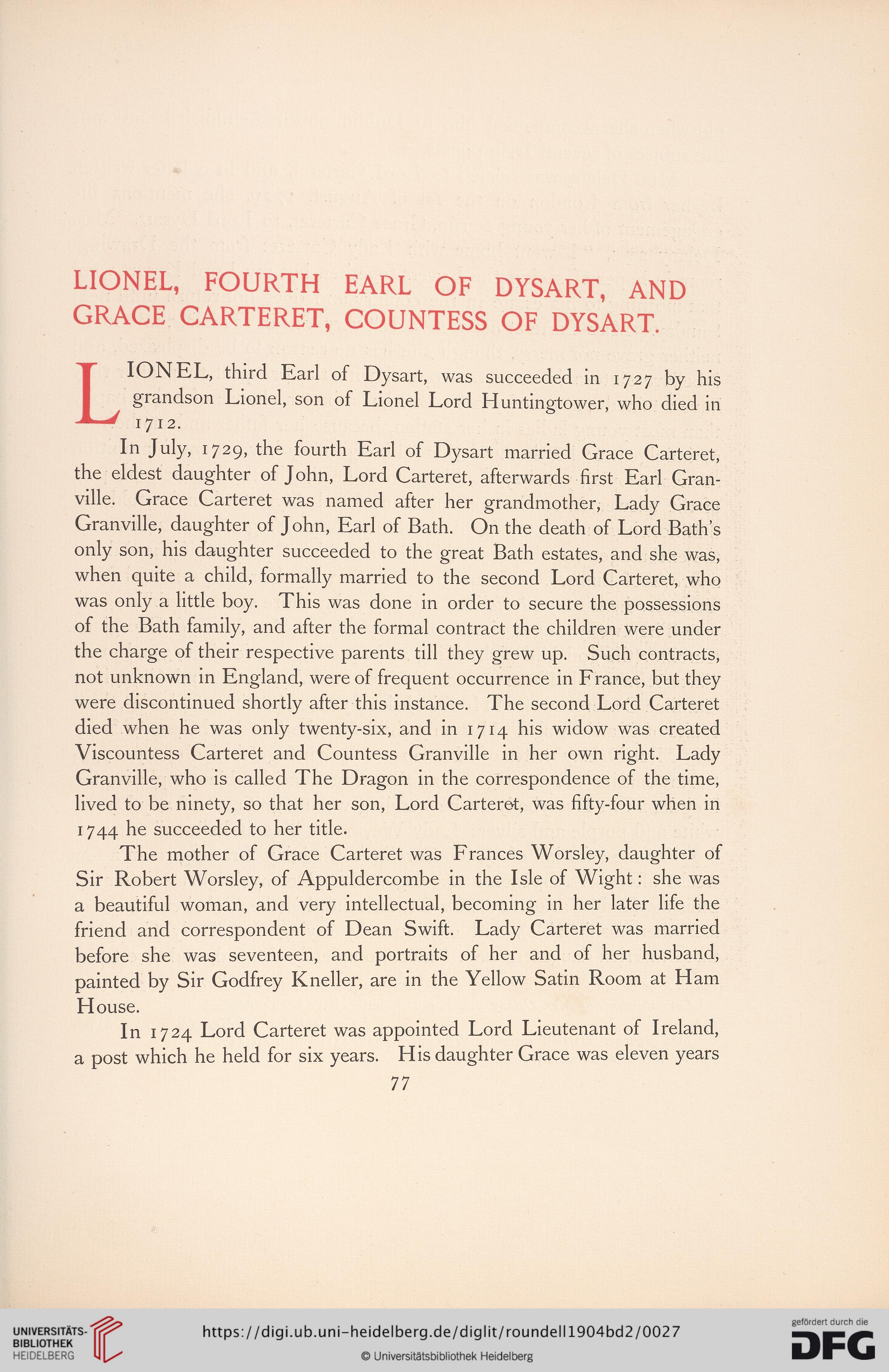LIONEL, FOURTH EARL OF DYSART, AND
GRACE CARTERET, COUNTESS OF DYSART.
LIONEL, third Earl of Dysart, was succeeded in 1727 by his
grandson Lionel, son of Lionel Lord Huntingtower, who died in
1712.
Ill July, 1729, the fourth Earl of Dysart married Grace Carteret,
the eldest daughter of John, Lord Carteret, afterwards first Earl Gran-
ville. Grace Carteret was named after her grandmother, Lady Grace
Granville, daughter of John, Earl of Bath. On the death of Lord Bath’s
only son, his daughter succeeded to the great Bath estates, and she was,
when quite a child, formally married to the second Lord Carteret, who
was only a little boy. This was done in order to secure the possessions
of the Bath family, and after the formal contract the children were under
the charge of their respective parents till they grew up. Such contracts,
not unknown in England, were of frequent occurrence in France, but they
were discontinued shortly after this instance. The second Lord Carteret
died when he was only twenty-six, and in 1714 his widow was created
Viscountess Carteret and Countess Granville in her own right. Lady
Granville, who is called The Dragon in the correspondence of the time,
lived to be ninety, so that her son, Lord Carteret, was fifty-four when in
1744 he succeeded to her title.
The mother of Grace Carteret was Frances Worsley, daughter of
Sir Robert Worsley, of Appuldercombe in the Isle of Wight: she was
a beautiful woman, and very intellectual, becoming in her later life the
friend and correspondent of Dean Swift. Lady Carteret was married
before she was seventeen, and portraits of her and of her husband,
painted by Sir Godfrey Kneller, are in the Yellow Satin Room at Ham
House.
In 1724 Lord Carteret was appointed Lord Lieutenant of Ireland,
a post which he held for six years. His daughter Grace was eleven years
77
GRACE CARTERET, COUNTESS OF DYSART.
LIONEL, third Earl of Dysart, was succeeded in 1727 by his
grandson Lionel, son of Lionel Lord Huntingtower, who died in
1712.
Ill July, 1729, the fourth Earl of Dysart married Grace Carteret,
the eldest daughter of John, Lord Carteret, afterwards first Earl Gran-
ville. Grace Carteret was named after her grandmother, Lady Grace
Granville, daughter of John, Earl of Bath. On the death of Lord Bath’s
only son, his daughter succeeded to the great Bath estates, and she was,
when quite a child, formally married to the second Lord Carteret, who
was only a little boy. This was done in order to secure the possessions
of the Bath family, and after the formal contract the children were under
the charge of their respective parents till they grew up. Such contracts,
not unknown in England, were of frequent occurrence in France, but they
were discontinued shortly after this instance. The second Lord Carteret
died when he was only twenty-six, and in 1714 his widow was created
Viscountess Carteret and Countess Granville in her own right. Lady
Granville, who is called The Dragon in the correspondence of the time,
lived to be ninety, so that her son, Lord Carteret, was fifty-four when in
1744 he succeeded to her title.
The mother of Grace Carteret was Frances Worsley, daughter of
Sir Robert Worsley, of Appuldercombe in the Isle of Wight: she was
a beautiful woman, and very intellectual, becoming in her later life the
friend and correspondent of Dean Swift. Lady Carteret was married
before she was seventeen, and portraits of her and of her husband,
painted by Sir Godfrey Kneller, are in the Yellow Satin Room at Ham
House.
In 1724 Lord Carteret was appointed Lord Lieutenant of Ireland,
a post which he held for six years. His daughter Grace was eleven years
77




